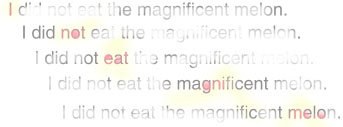

 |
Greg Kochanski |  |
This is a comment on/review of "Categorical Perception of Boundary Tones in German'', Katrin Schneider and Britta Lintfert, 15th ICPhS (International Conference on the Phonetic Sciences) Barcelona, 2003. Paper 0139.
The paper consists of two experiments to test whether or not intonation contours follow the standard model of categorical perception. In that model, people are presented with a series of stimuli (sounds) and asked to classify them as either A or B as the stimulus is smoothly varied. This kind of experiment typically gives an S-shaped "identification curve" of the probability that the subjects classify a stimulus as B. Then, a "discrimination curve" is measured by presenting the subjects with pairs of sounds. These sounds are either identical or slightly different, and keeping track of whether or not they can tell whether they are different or not.
In a standard categorical perception experiment, you are said to have categorical perception if both of these things are true:
The paper follows that methodology, but does not prove its claim. First, it is short on statistical tests. The only test is a correlation between the position of the best discrimination for each subject with the midpoint of the corresponding identification curve.
To be honest, I don't see that they had much hope of proving anything. At each point in the discrimination curve, they only had six trials for each subject. Consequently, the shapes of their individual discrimination curves will be awful because the statistical errors on each point will be big, and some points will have positive errors and some negative errors. (The statistical errors on each point of a single-subject discrimination curve will be rougly 50% for six trials.)
Lumping all the subjects together perhaps gives enough data to construct a useful discrimination curve, but it is not one that matches the identification curve particularly well. It is rather too broad, not high enough in the middle, and not low enough at the ends. Oddly, the false alarm rate is small everywhere. If the subjects really could not discriminate within a category, the false alarm rate should be up at 50%, rather than down in the 10%-20% range that they observed.
Overall, the data is not a good match to what one should get for true categorical perception.
Further, the data analysis was seriously flawed. Six of the 24 subjects were excluded based on their results, which is bad practice. Specifically, two subjects had perfect discrimination within the categories, one could not discriminate even at the category boundary, and two had broad indistinct discrimination curves. In other words, all the subjects that they excluded were evidence against categorical perception.
Second, the experiment used phoneticians as subjects. These are people with special training, so their perceptions may be different or may be more conscious. Worse yet, their answers may be influenced by their expectations, especially if they are the authors themselves.
| [ Papers | kochanski.org | Phonetics Lab | Oxford ] | Last Modified Thu Oct 18 05:35:12 2007 | Greg Kochanski: [ Home ] |